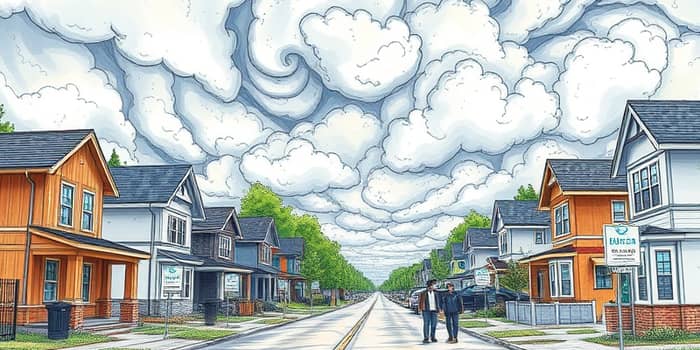
In 2025, the U.S. housing market is experiencing a clear slowdown as mortgage rates remain stubbornly above 6%. Homebuyers, sellers, and builders alike are navigating a challenging landscape defined by elevated borrowing costs and constrained supply.
Although home values continue to rise modestly, affordability has become the top concern for many Americans. This article explores the forces reshaping the sector and offers practical advice to thrive despite the headwinds.
After dipping to a low of 6.2% in September 2024, the average 30-year mortgage rate has climbed back toward 7%, settling at around 6.94% in late May. So far in 2025, rates have averaged about 6.5%, slightly lower than last year’s 6.7% but still far from the pandemic-era lows near 2.65%.
Experts predict that rates will remain elevated throughout the year. Even if the Federal Reserve trims its benchmark rate, mortgage rates typically move on different signals—like bond yields and inflation expectations. Forecasts from Fannie Mae and J.P. Morgan both point to a higher-for-longer interest climate, with only modest declines toward year-end.
As mortgage payments rise, affordability has become the chief obstacle for prospective buyers. With the national median home price around $367,969, a 20% down payment now requires tens of thousands of dollars—and higher rates only deepen the financial strain.
Surveys show that many buyers are adopting a wait-and-see approach, hoping for rate relief or pricing adjustments. First-time buyers in particular face hurdles, as elevated costs push monthly payments beyond 30% of typical household incomes in many markets.
Despite the cooling demand, home prices continue to inch upward, projected to grow roughly 3% in 2025. Regional disparities abound—some Sun Belt cities still see double-digit appreciation, while parts of the Midwest and Northeast flatten or even dip slightly.
Inventory has gradually improved, but remains tight compared to historic norms. In April 2025, the U.S. had about 4.4 months’ supply of existing homes, up 20.8% from a year ago but still shy of the balanced 5–6 month threshold.
One critical challenge is the so-called lock-in effect: homeowners with mortgages locked in at historically low rates are hesitant to sell, fearing the jump to current rates. This reduces turnover and keeps a significant portion of existing inventory off the market.
For those considering a move, it may pay to explore adjustable-rate mortgage options or negotiate interest-rate buy-downs. In some cases, sellers can offer rate credits to incentivize buyers and ease the cost of higher borrowing.
Builders have responded to the shortage of existing inventory by ramping up construction. New home listings are at their highest since 2007, with about 481,000 newly built homes available. Speculative homes also outnumber long-term averages by 40%.
However, rising materials costs and labor constraints continue to pressure profit margins and slow delivery. Builders who adapt by focusing on efficient designs, modular components, and strategic land acquisitions will find more resilience in this climate.
Macro factors play an outsized role in shaping the housing outlook. After three rate cuts in late 2024, the Fed is holding steady amid persistent inflation concerns.
Market cooling is uneven across the country. Rapidly growing Sun Belt metros still see tight inventory and price growth, while cooler secondary markets in the Rust Belt offer greater affordability—albeit with slower appreciation.
Local factors such as job market strength, migration patterns, and zoning regulations can dramatically influence how each region weathers the rate environment.
The consensus is clear: mortgage rates will stay above 6% for the foreseeable future, keeping buyers cautious and slowing sales. Existing-home sales are expected to tick up to about 4.25 million, but remain roughly 20% below 2019 levels.
Despite the challenges, strategic players can still find opportunities. Here are actionable steps to navigate the current market:
Real estate professionals should lean into digital marketing, virtual tours, and flexible financing partnerships to sustain engagement and close deals.
Though the housing sector is undeniably cooling, resilience and innovation can help buyers, sellers, and builders succeed. By understanding the forces at play and adopting practical strategies, stakeholders can navigate this complex environment with confidence and purpose.
References













